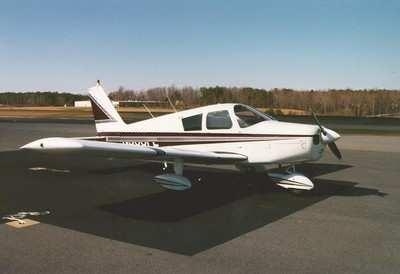Accident Near Warrenton, VA, Involved NTSB, FAA Personnel. Canadian Agency Leading The Investigation
The Transportation Safety Board of Canada (TSB) has released factual information in an accident in May involving a V35B Bonanza and a Piper PA-28-140 Cherokee, which collided in mid-air near Warrenton, VA. Since the accident airplanes were owned by NTSB and FAA employees, the Canadian agency was asked to take the lead for the investigation under Annex 13 of the Convention on International Civil Aviation, Section 5.1. The investigation is being conducted under the laws and policies applicable to the TSB.

On 28 May 2012, at 1605 Eastern Daylight Time, near Warrenton, Virginia, a Beechcraft V35B Bonanza (depicted in 3-view) owned by an NTSB employee was in a shallow climb headed southbound when it collided with a Piper PA-28-140 Cherokee (similar aircraft pictured below) owned by an FAA employee, which was in level flight headed in a southeasterly direction. As a result of the collision, the Bonanza broke up in flight and the pilot and flight instructor were fatally injured in the crash. The pilot, who was the sole occupant of the Cherokee, was able to conduct a forced landing in a pasture approximately 6 nautical miles south of the Warrenton-Fauquier Airport (KHWY). The pilot was taken to hospital and later released.
The investigation team is led by TSB Investigator-in-Charge, Jon Lee. Mr. Lee has 25 years aviation experience: 12 years as a commercial pilot in the aviation industry, and 13 years as an aircraft accident investigator. He is assisted in this investigation by experts in flight operations, aircraft performance, aircraft systems, aircraft engines, human performance and air traffic control. While most of these experts come from the TSB, assistance has also been provided by the NTSB, the FAA, Hawker Beechcraft and Piper Aircraft Inc.
Each investigation consists of three phases. The first phase is the field phase, when information is gathered from a number of sources; it includes examination of the wreckage and accident site. The second phase is the post-field phase where information continues to be gathered and the analysis begins. The final phase is the report production phase. This phase includes writing the report, consulting designated reviewers and, once the Board approves the final report, preparing the report for release to the public.
This investigation has now entered phase 2. While continuing to accumulate the information it needs, the team has now begun the work of analyzing the considerable amount of data in order to determine what happened, why it happened and, what needs to be done to ensure this does not happen again.
Progress has been made in a number of areas. The accident site was extensively photographed and documented, and all major aircraft components were located. The team reviewed eye-witness statements taken by local law enforcement officials, and had several conversations with the surviving pilot. Air traffic controllers were also interviewed. Relevant records were examined. FAA air traffic radar data along with flight path information recorded on a GPS in the Cherokee were retrieved. This information provides valuable data that will assist investigators in understanding what happened during the moments leading up to the collision.

Both aircraft were certified, equipped and maintained in accordance with existing regulations and approved procedures. Nothing was found to indicate that there were any airframe failures or system malfunctions before or during the flight. All control surfaces were accounted for, and all damage to both aircraft was attributable to the collision and impact forces. Records indicate that the Bonanza pilot and instructor and the Cherokee pilot were certified and qualified for the flight in accordance with existing regulations. Both aircraft were flying under visual flight rules (VFR). VFR flight requires a pilot to be able to see outside the cockpit, to control the aircraft's attitude, navigate, and avoid obstacles and other aircraft. Governing agencies establish specific requirements for VFR flight, including minimum visibility and distance from clouds, to ensure that aircraft operating under VFR are visible from enough distance to ensure safety. The weather for the Warrenton area was consistent with good
visual meteorological conditions with visibilities well in excess of the minimums required for VFR.
After departing the Culpeper Airport and levelling at 2000 feet above sea level, the pilot of the Cherokee contacted Potomac terminal radar approach control (TRACON) and requested air traffic control services to conduct a practice instrument approach into the Warrenton Airport. The Potomac TRACON controller was in the process of radar identifying the Cherokee when the collision occurred. The collision alert alarm had sounded on the controller's console before the collision.
The TSB is proceeding along several avenues of investigation concurrently in order to understand why the aircraft collided. To that end, investigators, assisted by specialists in aircraft performance and human performance, are reviewing factors that may have contributed to this tragic accident. A field-of-view analysis is being performed for each aircraft to determine whether either aircraft would have been visible to either pilot as they approached.
The TSB has classified this occurrence as a midair collision. The issues being actively investigated are the effectiveness of "see and be seen" as a defense for aircraft flying under VFR, and FAA policies and procedures regarding controller responses to collision alerts between VFR aircraft.
The TSB indicates that should the investigation team uncover a safety deficiency that represents an immediate risk to aviation, the Board will communicate without delay in an effort to make the aviation system safer.
 Classic Aero-TV: The Switchblade Flying Car FLIES!
Classic Aero-TV: The Switchblade Flying Car FLIES! ANN FAQ: Q&A 101
ANN FAQ: Q&A 101 ANN's Daily Aero-Term (04.12.24): Discrete Code
ANN's Daily Aero-Term (04.12.24): Discrete Code ANN's Daily Aero-Term (04.13.24): Beyond Visual Line Of Sight (BVLOS)
ANN's Daily Aero-Term (04.13.24): Beyond Visual Line Of Sight (BVLOS) ANN's Daily Aero-Linx (04.13.24)
ANN's Daily Aero-Linx (04.13.24)




